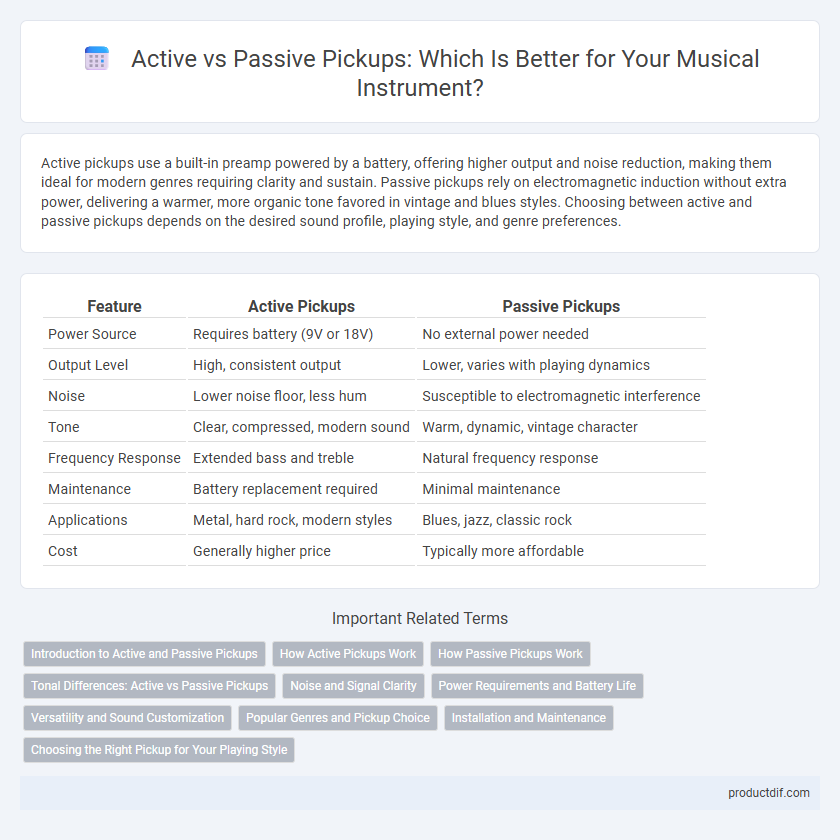Active pickups use a built-in preamp powered by a battery, offering higher output and noise reduction, making them ideal for modern genres requiring clarity and sustain. Passive pickups rely on electromagnetic induction without extra power, delivering a warmer, more organic tone favored in vintage and blues styles. Choosing between active and passive pickups depends on the desired sound profile, playing style, and genre preferences.
Table of Comparison
| Feature | Active Pickups | Passive Pickups |
|---|---|---|
| Power Source | Requires battery (9V or 18V) | No external power needed |
| Output Level | High, consistent output | Lower, varies with playing dynamics |
| Noise | Lower noise floor, less hum | Susceptible to electromagnetic interference |
| Tone | Clear, compressed, modern sound | Warm, dynamic, vintage character |
| Frequency Response | Extended bass and treble | Natural frequency response |
| Maintenance | Battery replacement required | Minimal maintenance |
| Applications | Metal, hard rock, modern styles | Blues, jazz, classic rock |
| Cost | Generally higher price | Typically more affordable |
Introduction to Active and Passive Pickups
Active pickups contain built-in preamps powered by batteries, enhancing signal output and providing higher gain and clarity, especially suited for genres requiring clear, defined tones. Passive pickups rely on magnetic coils without external power, generating a warmer, more organic sound favored in traditional and vintage-style guitars. Choosing between active and passive pickups depends on desired tonal characteristics and playing style preferences.
How Active Pickups Work
Active pickups use an internal battery-powered preamp to boost the guitar signal, resulting in higher output and reduced noise compared to passive pickups. A built-in preamplifier shapes the tone by increasing signal strength before it reaches the amplifier, enhancing clarity and sustain. This electronic circuitry allows for greater control over frequency response and dynamic range, making active pickups ideal for heavy distortion and modern playing styles.
How Passive Pickups Work
Passive pickups operate without external power, using electromagnetic induction to convert string vibrations into electrical signals. Their design typically involves magnets wrapped with copper wire coils, creating an alternating current as the guitar strings disturb the magnetic field. This process results in a warm, natural tone favored in many traditional and vintage-style guitars.
Tonal Differences: Active vs Passive Pickups
Active pickups deliver a clearer, more consistent output with enhanced bass response and higher gain, making them ideal for genres requiring precise, modern tones. Passive pickups offer a warmer, more dynamic sound with natural harmonic overtones, favored for vintage and classic music styles. The tonal difference stems from active pickups' built-in preamps that boost and shape the signal, whereas passive pickups rely solely on the magnetic coil's characteristics.
Noise and Signal Clarity
Active pickups utilize built-in preamps to provide higher output and enhanced signal clarity, significantly reducing background noise and hum compared to passive pickups. Passive pickups rely solely on magnetic coils, which can be more susceptible to electromagnetic interference, resulting in a noisier signal. Musicians seeking cleaner tones and improved signal-to-noise ratios often prefer active pickups for genres requiring precise sound reproduction.
Power Requirements and Battery Life
Active pickups require a dedicated power source, typically a 9V battery, to operate their built-in preamp, resulting in higher power consumption compared to passive pickups. This power requirement ensures a stronger, noise-free signal but limits battery life, often lasting between 300 to 500 hours of playtime before needing replacement. Passive pickups operate without batteries, relying solely on the guitar's magnetic field, offering unlimited playtime but with lower output and increased susceptibility to noise.
Versatility and Sound Customization
Active pickups offer greater versatility and sound customization due to their built-in preamp, which provides a higher output and a wider frequency response, allowing musicians to sculpt tones with precision. Passive pickups, while delivering a warmer, more organic sound, have limited control over tone shaping but excel in dynamic sensitivity and vintage character. Players seeking extensive tonal options and modern sound flexibility often prefer active pickups, whereas those valuing simplicity and traditional tonal warmth lean toward passive designs.
Popular Genres and Pickup Choice
Active pickups dominate genres like metal and hard rock due to their high output and clarity, which enhance heavy distortion and fast playing techniques. Passive pickups remain favored in blues, jazz, and classic rock for their warmer, more dynamic tone that captures subtle nuances and vintage sounds. Guitarists often select pickups based on the tonal demands of their genre, balancing aggression and articulation with warmth and expressiveness.
Installation and Maintenance
Active pickups require a power source, typically a 9V battery, making installation more complex than passive pickups, which do not need external power. Maintenance for active pickups includes regular battery replacement and occasional wiring checks, while passive pickups demand minimal upkeep, mainly focusing on cleaning and ensuring stable solder connections. Choosing between active and passive pickups depends on balancing enhanced sound control with the simplicity of installation and maintenance.
Choosing the Right Pickup for Your Playing Style
Active pickups offer higher output and reduced noise, making them ideal for players seeking a powerful, consistent tone often favored in metal and hard rock genres. Passive pickups provide a warmer, more dynamic sound with greater tonal variation, preferred by blues, jazz, and classic rock musicians who prioritize expressiveness and vintage character. Selecting the right pickup depends on your playing style, desired tonal qualities, and the genre you perform, ensuring your instrument delivers the optimal sound for your musical expression.
Active Pickups vs Passive Pickups Infographic

 productdif.com
productdif.com